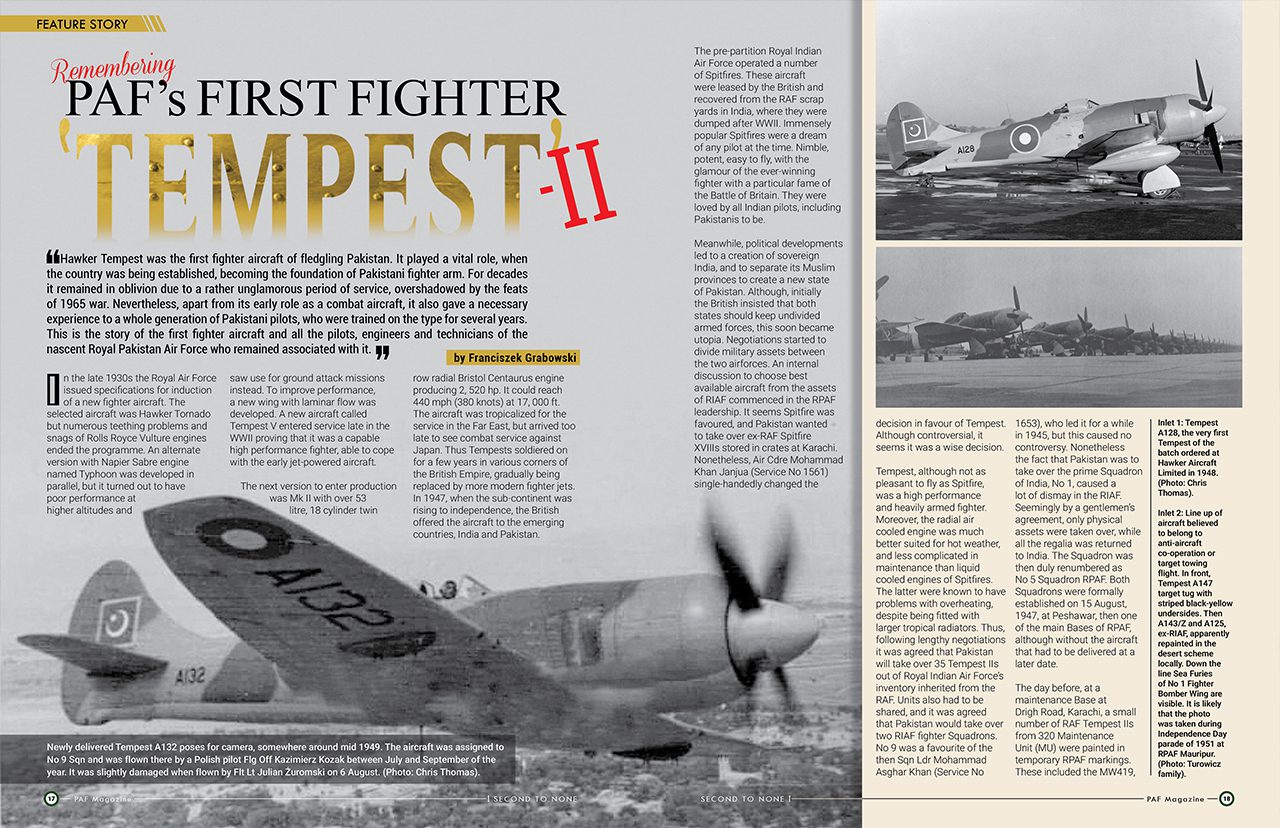Hawker Tempest was the first fighter aircraft of fledgling Pakistan. It played a vital role, when the country was being established, becoming the foundation of Pakistani fighter arm. For decades it remained in oblivion due to a rather unglamorous period of service, overshadowed by the feats of 1965 war. Nevertheless, apart from its early role as a combat aircraft, it also gave a necessary experience to a whole generation of Pakistani pilots, who were trained on the type for several years. This is the story of the first fighter aircraft and all the pilots, engineers and technicians of the nascent Royal Pakistan Air Force who remained associated with it.
In the late 1930s the Royal Air Force issued specifications for induction of a new fighter aircraft. The selected aircraft was Hawker Tornado but numerous teething problems and snags of Rolls Royce Vulture engines ended the programme. An alternate version with Napier Sabre engine named Typhoon was developed in parallel, but it turned out to have poor performance at higher altitudes and saw use for ground attack missions instead. To improve performance, a new wing with laminar flow was developed. A new aircraft called Tempest V entered service late in the WWII proving that it was a capable high performance fighter, able to cope with the early jet-powered aircraft.
The next version to enter production was Mk II with over 53 litre, 18 cylinder twin row radial Bristol Centaurus engine producing 2, 520 hp. It could reach 440 mph (380 knots) at 17, 000 ft. The aircraft was tropicalized for the service in the Far East, but arrived too late to see combat service against Japan. Thus Tempests soldiered on for a few years in various corners of the British Empire, gradually being replaced by more modern fighter jets. In 1947, when the sub-continent was rising to independence, the British offered the aircraft to the emerging countries, India and Pakistan.
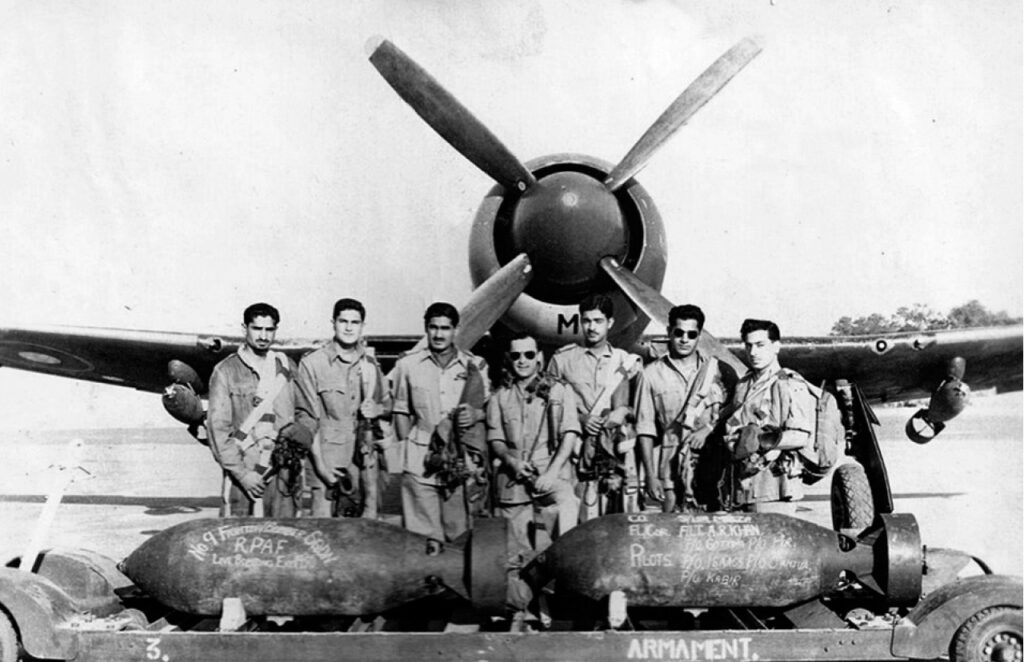
The pre-partition Royal Indian Air Force operated a number of Spitfires. These aircraft were leased by the British and recovered from the RAF scrap yards in India, where they were dumped after WWII. Immensely popular Spitfires were a dream of any pilot at the time. Nimble, potent, easy to fly, with the glamour of the ever-winning fighter with a particular fame of the Battle of Britain. They were loved by all Indian pilots, including Pakistanis to be.
Meanwhile, political developments led to a creation of sovereign India, and to separate its Muslim provinces to create a new state of Pakistan. Although, initially the British insisted that both states should keep undivided armed forces, this soon became utopia. Negotiations started to divide military assets between the two airforces. An internal discussion to choose best available aircraft from the assets of RIAF commenced in the RPAF leadership. It seems Spitfire was favoured, and Pakistan wanted to take over ex-RAF Spitfire XVIIIs stored in crates at Karachi. Nonetheless, Air Cdre Mohammad Khan Janjua (Service No 1561) single-handedly changed the decision in favour of Tempest. Although controversial, it seems it was a wise decision.
Tempest, although not as pleasant to fly as Spitfire, was a high performance and heavily armed fighter. Moreover, the radial air cooled engine was much better suited for hot weather, and less complicated in maintenance than liquid cooled engines of Spitfires. The latter were known to have problems with overheating, despite being fitted with larger tropical radiators. Thus, following lengthy negotiations it was agreed that Pakistan will take over 35 Tempest IIs out of Royal Indian Air Force’s inventory inherited from the RAF. Units also had to be shared, and it was agreed that Pakistan would take over two RIAF fighter Squadrons. No 9 was a favourite of the then Sqn Ldr Mohammad Asghar Khan (Service No 1653), who led it for a while in 1945, but this caused no controversy. Nonetheless the fact that Pakistan was to take over the prime Squadron of India, No 1, caused a lot of dismay in the RIAF. Seemingly by a gentlemen’s agreement, only physical assets were taken over, while all the regalia was returned to India. The Squadron was then duly renumbered as No 5 Squadron RPAF. Both Squadrons were formally established on 15 August, 1947, at Peshawar, then one of the main Bases of RPAF, although without the aircraft that had to be delivered at a later date.
The day before, at a maintenance Base at Drigh Road, Karachi, a small number of RAF Tempest IIs from 320 Maintenance Unit (MU) were painted in temporary RPAF markings. These included the MW419, PR653 and PR713. They flew past during Pakistan Independence celebrations by the RPAF pilots, including Sqn Ldr Zahiruddin Ahmad (Service No 1672), a newly appointed Officer Commanding of No 5 Sqn.
The exact date of the introduction of the type to the RPAF is not known. In the books, the aircraft were passed from the RAF to the RIAF on 25 September 1947, and immediately after, the RIAF handed over part of them to the RPAF. In reality, the process of selection of aircraft and establishment of squadrons started even before the official declaration of independence, in August 1947. They were then flown to RPAF Peshawar, which became the main station of the air force.
Each Squadron had to have one Flight of 6 pilots and 8 aircraft (4 in use and 4 in the immediate reserve), this was due to shortage of both aircraft and personnel. They formed the Fighter Bomber Wing, and maintenance was provided by the Maintenance Wing at the base. The maintenance centres for both airframes (No 101 MU) and engines (No 102 MU) were based at RPAF Drigh Road in Karachi, more than 800 miles south of Peshawar. Here the aircraft taken over from RIAF stocks were overhauled, as they were in reasonably good condition following a few years of RAF service and subsequent storage. By early 1949, only 28 Tempests were returned to service with serials A100-A127. Initially all the RPAF aircraft wore original RAF serials, but they were gradually replaced through the remaining months of 1947. Apart from aircraft assigned to combat units, few were assigned to a Conversion Flight at RPAF College, Risalpur for pilots’ training, and the rest were kept in reserve.
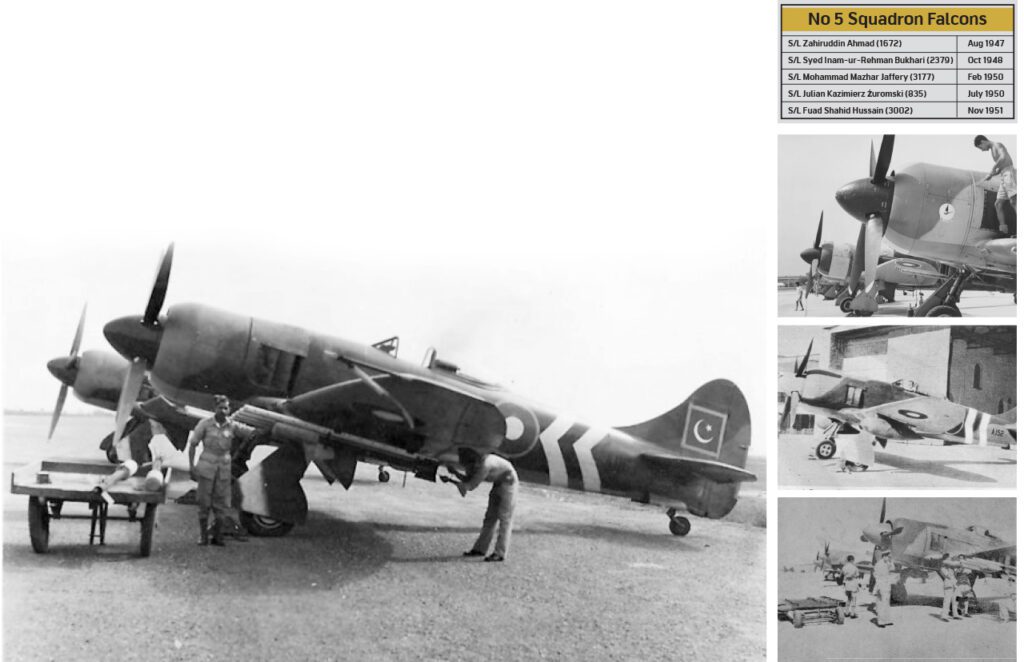
Although Tempests were not deployed in Kashmir against India, in December, 1947, they received quick identification markings in form of white stripes on wings and fuselage. The same order was officially introduced as RPAF markings. At the same time, RIAF Tempest wore the same camouflage scheme as the RPAF aircraft, with a disruptive green-grey pattern. Also the early ‘Chakra’ roundels were not easy to recognise from Pakistan’s white-green roundels in high stress conditions.
After the Independence, the Tempests were almost immediately deployed for operations against tribesmen in Waziristan, who continued their so-called Faqir of Ipi rebellion that started during the British rule. In December 1947, No 5 and No 9 Sqns provided air cover to the army withdrawing from Razmak during Operation ‘Curzon’, making 47 sorties out of Miranshah. Other operations included patrolling of rebellious areas, and attacking targets of opportunity and those indicated by army units. For such operations, an independent detachment of two aircraft was established at Miranshah, operated by the pilots seconded by each squadron in turn.
Later, a deployment of each squadron, consisting of two to four aircraft operated from there approximately for three months. Miranshah could hardly be called an airbase. It was limited to a short airstrip, and a pilots’ hut (or rather roof) just next to the walls of Fort Miranshah. Pilots and ground crew lived in the Fort, and aircraft were rolled inside the walls of the Fort for protection against any hostile element. Still, service there was considered an attraction, for the young officers, especially bachelors, without a watchful eye of senior officers. The flying was nevertheless quite intense. During the period of May-July 1948, 60 operational sorties of 39 hours 50 minutes were flown. Over 70 bombs were dropped, as well as over 100 rockets and 4, 600 20 mm rounds were fired.
Apart from combat duties in North West Frontier Province (NWFP), flying at air displays and parades around the country was another important activity. These events were morale boosters and helped to promote the RPAF amongst the people of Pakistan.
Noticeably, No 9 Sqn took part in an air show in Lahore on 21 March 1948, with Flt Lt Abdul Naeem Aziz (Service No 1907), Flt Lt Abdur Rahim Khan (Service No 2927), Flg Off Masroor Hosain (Service No 3001) and Flg Off Fuad Shahid Hussain (Service No 3002) making the formation. Few weeks later, on 13 April 1948, the squadron presented a smartly turned out guard of honour to the visiting Governor-General, Quaid-i-Azam Mohammad Ali Jinnah, at Peshawar. Two days later the squadron pilots participated in a fly past in the honour of the Quaid’s visit to Risalpur, where he called upon the RPAF to be ‘Second to None’. In a similar vein, on 14 August, 1948, No 9 Sqn carried out a fly-past over Karachi during celebrations of the first anniversary of Pakistan’s independence. Interestingly, the radio set in the aircraft of formation leader, Sqn Ldr Abdul Naeem Aziz failed, but the display was performed according to schedule.
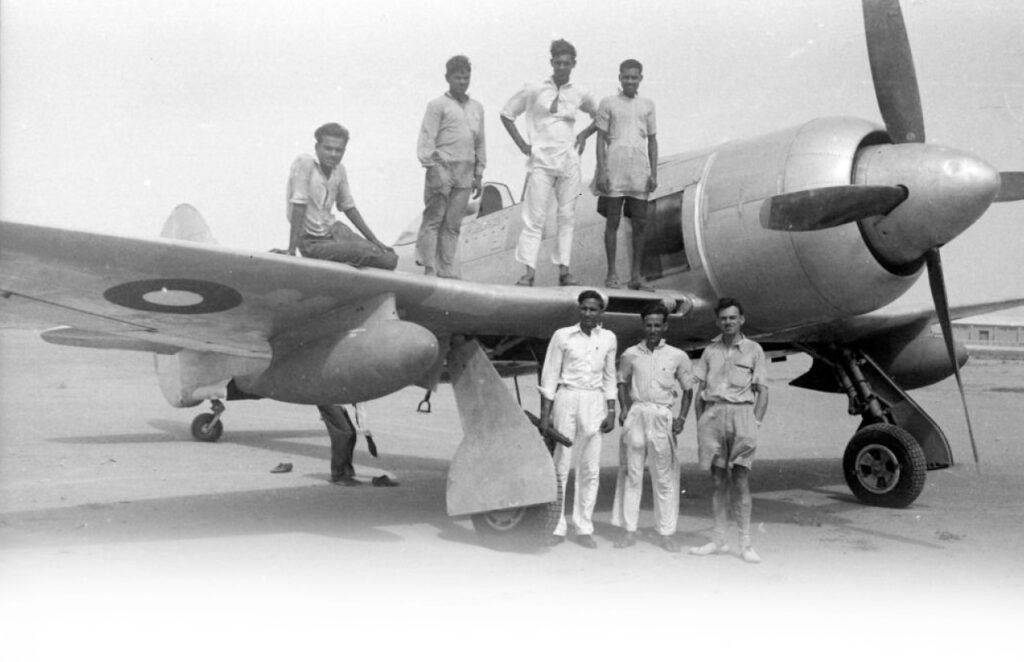
Soon after independence, the developing conflict in Kashmir led to an expansion plan envisioned by AVM Allan Perry Keene, the first C-in-C of the RPAF. It seemed obvious that the conflict would escalate, and that the RIAF will try to take control of the airspace over the disputed territories. Two new fighter squadrons were to be formed, No 14 and No 15. No 11 was reserved for Brigand Squadron, and No 12 for Halifax Squadron, with No 13 omitted for obvious reasons. Such an expansion was not possible without sufficient aircrew. Although the RPAF desperately tried to train as many pilots as possible, the training period of one year for each class did not allow to quickly fill vacancies. The solution was to hire Polish aircrew, who remained in exile after Poland was taken over by communists backed up by the Soviet Union. Having limited possibilities of employment in crisis-ridden Britain, they enthusiastically responded to the Pakistani offer. During December 1948, nearly 70 ex-Polish Air Force airmen and aircrew started to arrive. Few of the pilots were assigned to fighter squadrons. At the same time Pakistan acquired 24 Tempests that were struck off RAF charge and overhauled by Hawkers. This was a necessity, as the available aircraft did not allow to cover the needs of the expanded RPAF. Awaiting new arrivals, on 1 November 1948, No 14 Squadron was formed at Peshawar. Just four days later the first encounter between RIAF and RPAF aircraft took place, when two RIAF Tempests attacked a lone No 6 Sqn Dakota flown by Flg Off Dogar. Later, No 14 Squadron was disbanded on 15 January, 1949, and number plated. The reason was the fact that the unit lost two Tempests during December, and with no replacement aircraft, the situation became critical. The freshly acquired Tempest aircraft started to arrive only in March, 1949, and were immediately assigned to combat units. They were given serials A128-A151 and were easily distinguishable by their Desert Scheme. Recognition stripes were not applied.
The new commander, AVM Richard Atcherley, stressed upon rigorous training of aircrew. Extended courses had to be undertaken at all the training units. Each graduate was trained on Tempests in the Conversion Squadron at RPAF College of Flying Training, Risalpur, regardless of future assignment to fighter squadron or not. The Conversion Flight was upgraded to a squadron level, operating three Tempests.One of the results of the policy was that only a few Polish airmen made it to fighter units, against the initial plan. The rest were dispersed between various units to fill vacancies. Most of them left Pakistan by the end of 1949. Additionally, AVM Atcherley arranged to have a single Tempest assigned for his personal use and was based at RPAF Drigh Road. He was often seen flying over Karachi boosting the morale of both civilians and RPAF personnel.
In May, 1949, the contest for the first Inter Squadron Armament Trophy known as Perry Keene Trophy took place. In a rivalry between No 5 and No 9 Squadrons, the latter had the upper hand. The victorious team consisted of Sqn Ldr Aziz ur Rehman Khan (2358), Flt Lt Fuad Shahid Hussain (3002), Flg Off Imtiaz Hussain Khan Agha (3406), and a Pole, Flg Off Stefan Tronczyński (841).
Gradually, the situation of the RPAF improved. Induction of new aircraft allowed for increased training and operations, and vacated positions were gradually filled with newly trained pilots. At least four of the remaining ex-RIAF aircraft were returned to service during 1949. They were assigned serials following the Hawker’s batch aircraft, the highest known being A156.
It seems they were overhauled using newly acquired spares, and possibly cannibalised parts of written off aircraft, prior to being assigned to combat units.
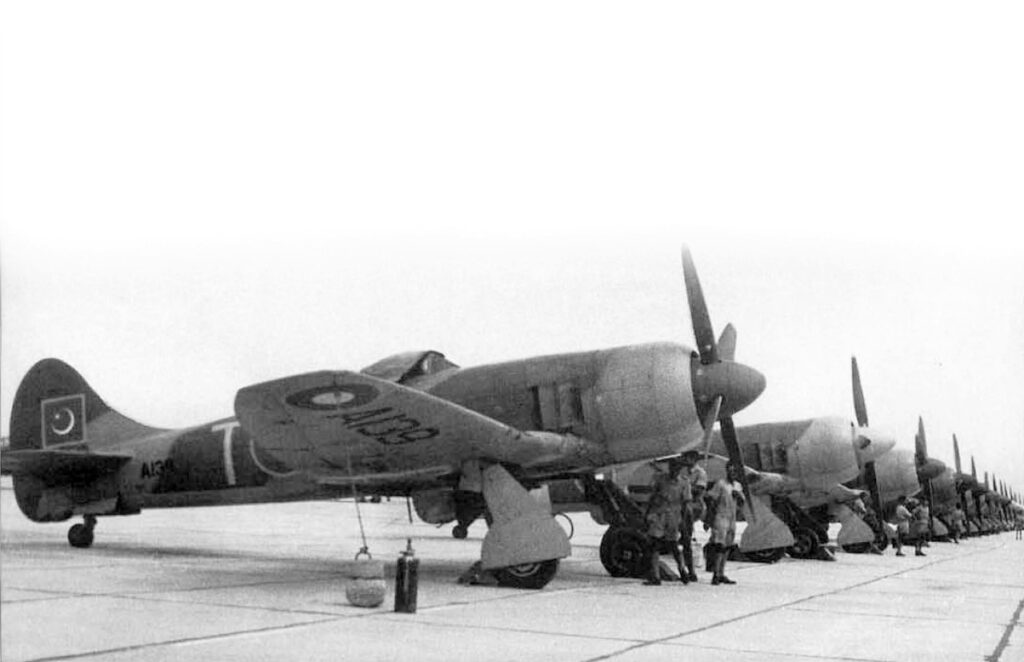
With an improved technical and personnel situation, No 14 Sqn was reactivated on 16 December, 1949, under the command of Squadron Leader Julian Kazimierz Żuromski (835). The squadron left for Miranshah on 24 March, 1950, on its first operational deployment against insurgency of the Faqir of Ipi.
There is very little information available on accidents and losses of RPAF aircraft. One identified fatality was Plt Off Ghani Khan (Service No 865) of No 9 Sqn, whose aircraft fatally crashed on 24 May, 1950. While performing a split-S dive at high altitude, his Tempest ran into high speed compressibility effects. The pilot lost control, and the aircraft broke up.
Starting from October, 1949, Pakistan took delivery of the first batch of 50 Sea Fury fighters. These planes ultimately replaced Tempests in combat units. The first Squadron, No 9, converted to the new aircraft in July 1950, but due to a shortage of Sea Furies, it flew Tempests once again from November 1950, until February 1951. Meanwhile all fighter bomber squadrons phased out their Tempests. The remaining aircraft, deemed as a reserve, were stored at Equipment Depot, RPAF Chaklala. Some of them continued service for a while in the Conversion Squadron at Risalpur, and were then relegated to second line duties like target towing or instructional airframes.
The delivery of the final batch of 21 Tempest aircraft, acquired from RAF stocks in Malaya, started in November 1951 and continued for an year. Following a long period in storage the aircraft were in bad condition and at least three were lost during the delivery flights. It is not known if all of the remaining aircraft were restored, or if a part of them were reduced to spares, the highest known serial being A165.
In September, 1953, No 12 Heavy Bomber Squadron was converted into Composite Squadron. In the new establishment, the Squadron had three flights: Air Headquarters Communication Flight operating Dakotas and a single Viking, Target Towing Flight with Tempests, and Heavy Bomber Flight flying Halifaxes. The last target towing Tempests were struck off charge in 1958. Unfortunately none survives to the present day.
Tempests, the first combat aircraft of Pakistan, was somewhat tricky to fly. Its agility and maneuverability made it a favourite of many pilots but its high performance did not come without a price. It was tricky to fly due to the tendency to swing on landing. Some pilots complained about the condition of the aircraft and crude finish of wartime production standards. Centaurus engines turned out to be temperamental and caused a lot of problems, partly due to a lack of spares and proper servicing. The replacement Sea Fury was found to be a superior aircraft in all respects. The last surviving Sea Furies remained in combat use until 1964.
Colours & Markings
The original 35 aircraft inherited from RAF stocks were painted in RAF colours. At the same time the RAF used two schemes: the Day Fighter Scheme, with Dark Green and Ocean Grey disruptive patterns with Medium Sea Grey under surfaces. The second was the Silver scheme with all surfaces painted silver. However, there is no evidence of the use of the Silver scheme on Pakistani Tempests.
National markings consisted of the Pakistani roundel, white and green with yellow outline on wings and fuselage. On the tail was a green square with yellow outline and a white crescent with star. On both sides of the aircraft, the crescent faced to the rear. Serials were painted in black on fuselage sides and on wings under surfaces in a typical RAF pattern of that time. They were introduced on 6 December, 1947.
At the time of partition, identification markings were applied in the form of double white stripes around the rear fuselage. Each band formed into a chevron on the fuselage sides (pointing forwards), and also double white chevrons at both wing roots and pointing towards the fuselage. There is a photo of a Tempest showing a single black stripe at both wing roots, but it is uncertain if it is a variation of the above marking or unrelated. Starting from 1949 those markings were gradually removed.
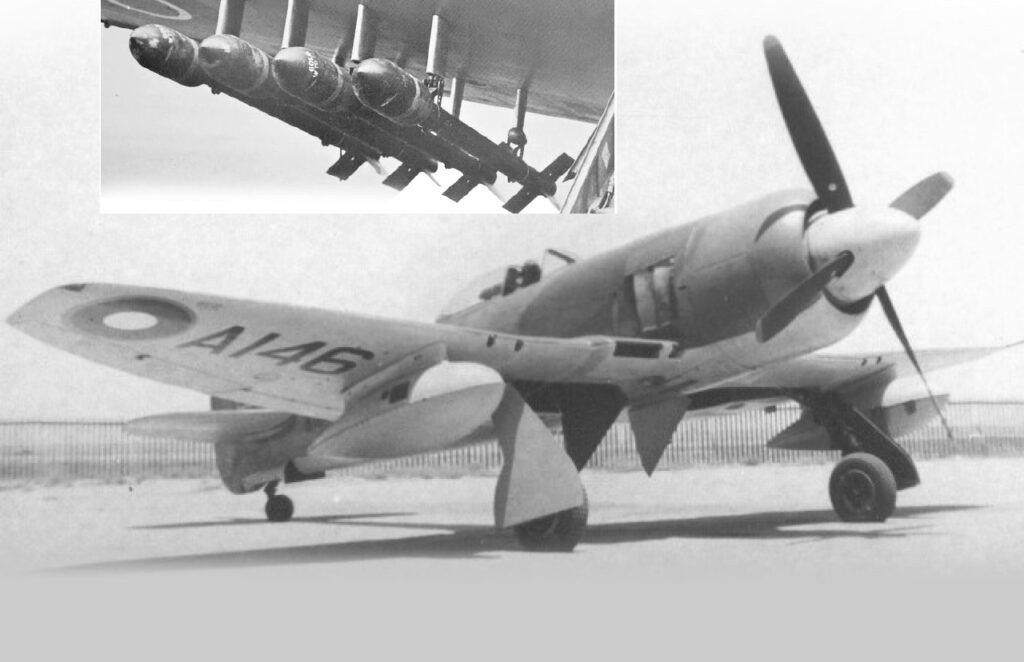
The 24 aircraft that were delivered from Hawker were painted in Desert Scheme of Dark Earth and Middle Stone disruptive pattern with Azure Blue under surfaces, and Azure Blue spinner. They did not receive identification stripes. Due to infrequent painting, repairs, and routine maintenance, aircraft started to look rather worn towards the end of their service.
It seems, after 1950 following the withdrawal of Tempests from operational units, the aircraft were gradually repainted in silver. Target tug aircraft had under surfaces painted in a single colour, possibly yellow or red.
Spinners were painted in squadron colours, No 5 Sqn dark blue and No 9 Sqn – red. The colour of No 14 Sqn is not confirmed. It should have been yellow, but photos suggest it was white or Azure Blue. Due to frequent movement of aircraft between the units, ‘wrong’ colours may have been seen. No squadron emblems, popular on Sea Furies, were noticed on Tempests. There is a single photo of a Tempest showing an emblem on the cowling, which cannot be tied with any unit, possibly a personal marking.
Squadrons used code letters in white in front (to nose) of the fuselage roundels and in black on front bottom cowling. Later, in 1949, with the removal of identification stripes from the tail, code letters moved after the roundel (gradually on old aircraft, and immediately on newly delivered ones). It seems that white section on the bottom of the front cowling was added as a background to the code at the same time, but no clear rule could be deduced. Only some aircraft received codes, probably those assigned to particular pilots, even if flown on an availability basis. Favourite letters were used, e.g. M for Sqn Ldr ‘Bertie’ Mirza, H for Flt Lt F S Hussain or Z for Flt Lt Zafar Chaudhry.
Whether the Tempest evoked strong affection or profound dislike in the pilots who flew it, it was a deadly partner of the Hurricanes, Spitfires and Furies of those times. This front line aeroplane had the armour and the firepower, qualities which made the Tempest deadlier in the hands of the PAF, determined to resist to the last man. It gave a new lease of life to a nascent Royal Pakistan Air Force and thus has acquired a significant place in the history of PAF.
